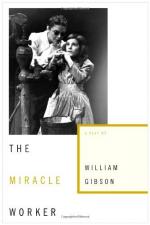|
This section contains 1,147 words (approx. 3 pages at 400 words per page) |

|
In this essay, Brustein analyzes The Miracle Worker and Gibson's motivationsforwriting the play.
Brustein is an American drama critic and the artistic director of the American Repertory Theater Company.
Near the conclusion of Two for the Seesaw, the rambunctious street urchin, Gittel Mosca, is gently informed that "after the verb to love, to help is the sweetest in the tongue." William Gibson, setting aside more serious concerns to anatomize the sweeter, softer virtues, has thus far dedicated his dramatic career to the definition and conjugation of these two verbs.
For, like the play which preceded it, The Miracle Worker written with the same wit and mounted with equal competence is essentially a two-character work about the relationship of kindness to love. The time has been set back to the 1880's, the seesaw has been freighted from New York to Alabama, and precariously balanced upon it now...
|
This section contains 1,147 words (approx. 3 pages at 400 words per page) |

|




